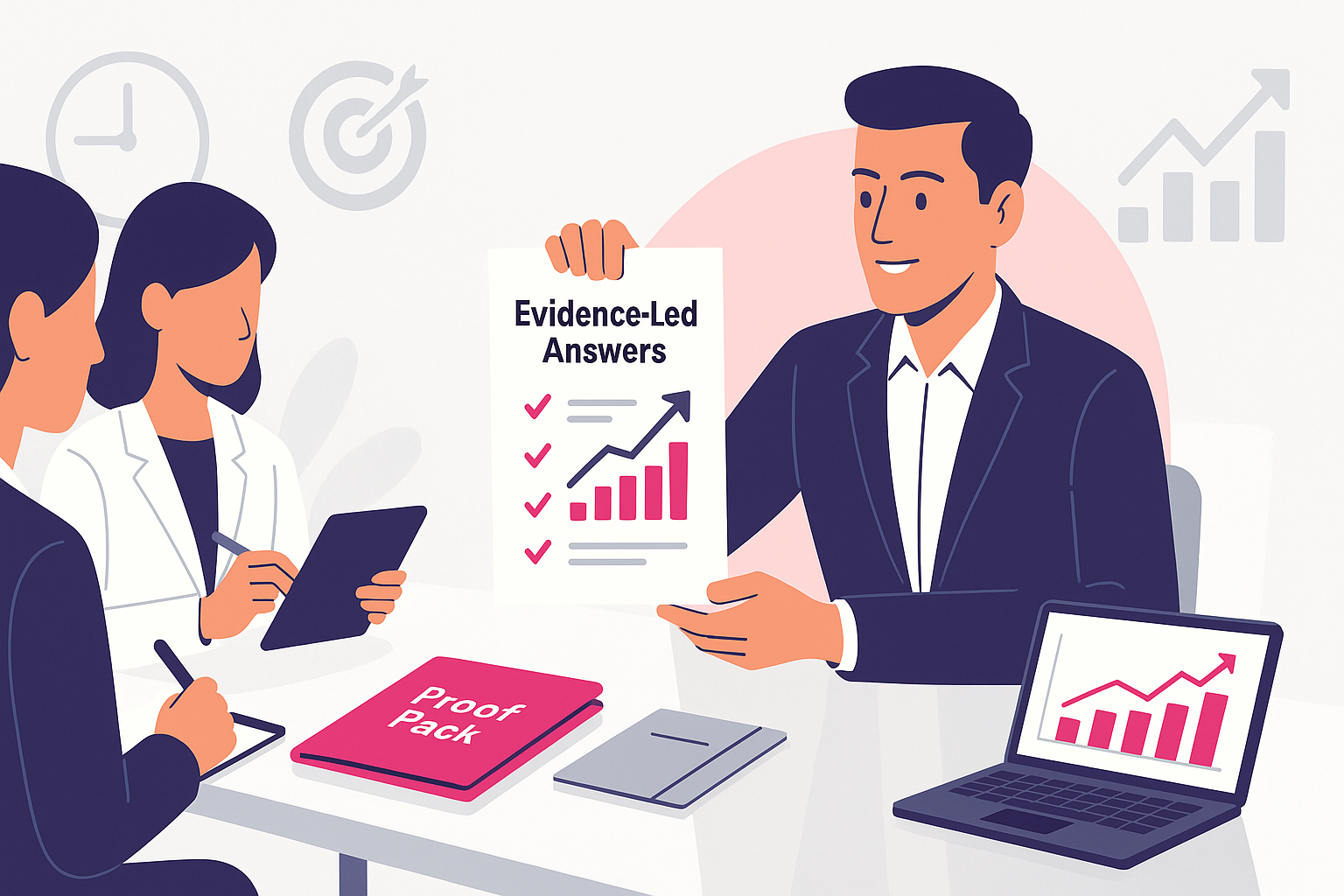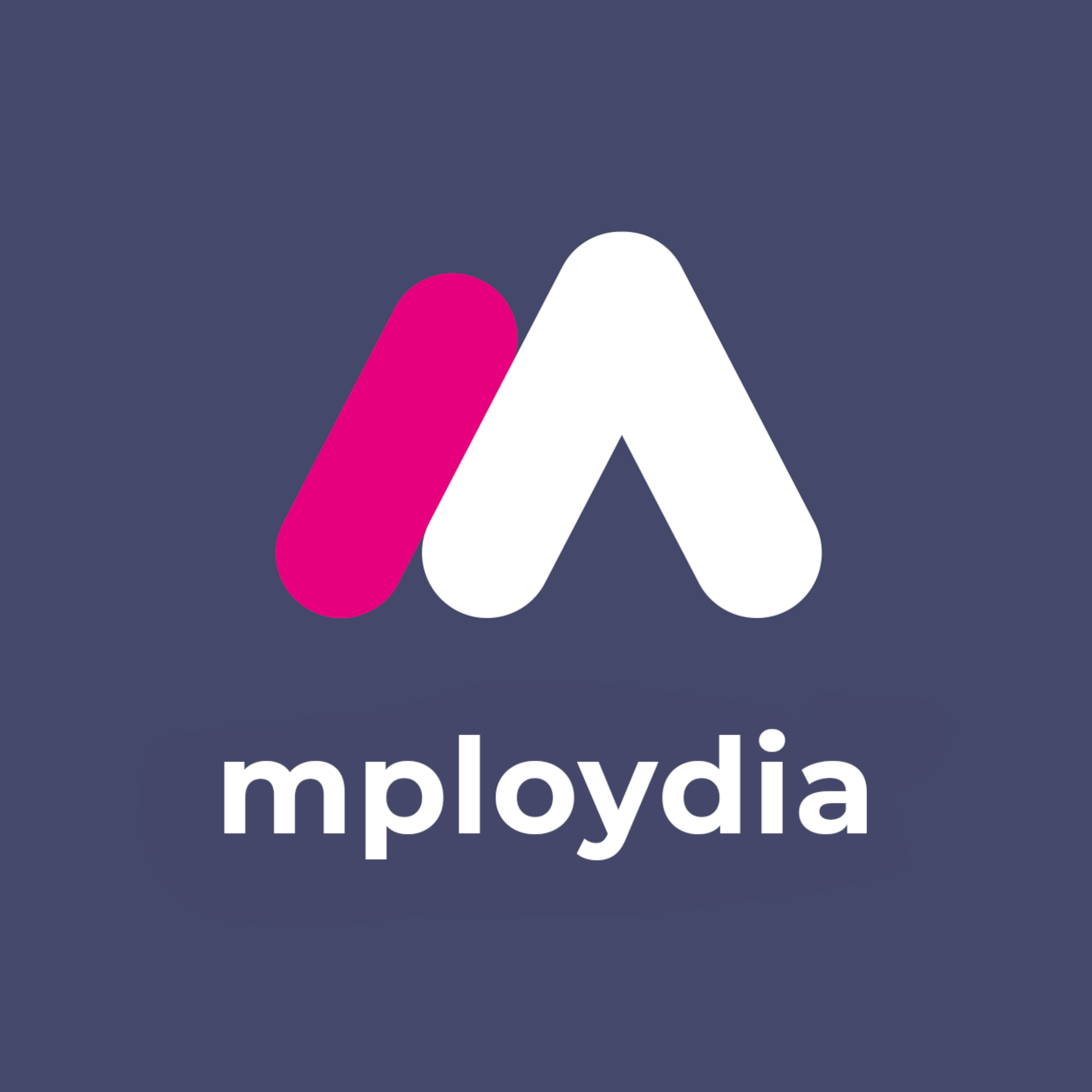
Evidence-Led Interview Answers That Secure Offers [Tactics]
Why evidence-led answers work
Evidence signals credibility and reduces perceived risk. Interviews are risk assessments. Your goal is to de-risk the hire with proof that you can deliver outcomes in the real world.
- Evidence shows you understand cause and effect, not just tasks.
- It proves you measure what matters and learn from data.
- It lets interviewers “see” you doing the job, not just hoping you can.
- It differentiates you from candidates who speak in vague generalities.
What counts as evidence? A precise definition
Evidence is any verifiable, checkable, or demonstrably plausible indicator that your actions caused a positive result. Use a mix:
- Quantitative: numbers, ratios, percentages, time saved, error rates, revenue, CSAT, NPS, AHT, conversion, attendance, output per hour, on-time rate.
- Qualitative: stakeholder quotes, customer feedback, coaching notes, email kudos, performance reviews.
- Third-party validation: certificates, badges, prizes, hackathons, published work, references.
- Artefacts: slides, dashboards, code repos, before/after screenshots, process maps, SOPs, templates.
- Comparative baselines: before vs after, target vs actual, you vs team average, month-on-month.
The one rule: always anchor your claim to a baseline and a result. “What changed and by how much?”
A simple framing model: STAR+P
Use STAR, then add P for Proof.
- Situation: context in one sentence.
- Task: what was required, with a clear success metric.
- Action: 2–4 decisive steps you took. No fluff.
- Result: quantified outcome against baseline or target.
- Proof: how you know it’s true and where it can be verified.
Example:
- Situation: Customer chat backlog averaged 120 tickets with 2-day response time.
- Task: Reduce backlog and improve response to under 24 hours in four weeks.
- Action: Built a triage template, created canned responses for top 10 queries, and reallocated shifts to cover peak periods.
- Result: Backlog cut 78 percent in three weeks. Median response time 7 hours. CSAT rose from 4.1 to 4.6.
- Proof: Zendesk dashboard screenshots, weekly ops report, manager email praising the change.
How to build an evidence bank in 7 days
You will not improvise credible proof on the spot. Prepare.
Day 1: Extract the outcomes
- List 10 pieces of work or projects from study, part-time jobs, volunteering, personal builds, internships.
- For each, write the outcome in one line. No duties, only changes achieved.
Day 2: Find baselines
- Note the “before” for each outcome. If unknown, estimate using a sensible proxy and label it as an estimate.
Day 3: Quantify
- Add numbers: percentage, count, time, cost, quality, speed, satisfaction, reliability.
Day 4: Gather artefacts
- Pull screenshots, links, files, references, certificates. Store in a cloud folder. Name files clearly, eg “AHT_Reduction_Before_After.png”.
Day 5: Draft STAR+P stories
- Write 6–8 stories aligned to the job description. Keep each story under 120 seconds spoken.
Day 6: Align to the job
- Map each story to a requirement in the job advert. Label them: “Teamwork”, “Initiative”, “Customer focus”, “Problem solving”, “Ownership”, “Learning agility”.
Day 7: Rehearse and tighten
- Practise aloud. Cut filler. Strengthen baselines. Add crisp numbers. Prepare to show proof when asked.
Quantification cheat sheet by function
If you’re stuck for numbers, use these common metrics.
Sales and growth
- Leads generated per week
- Conversion rate from lead to sale
- Average order value
- Revenue influenced or closed
- Follow-up speed and show-up rate
Customer service and support
- Average handle time (AHT)
- First response time
- First contact resolution
- CSAT/NPS
- Ticket backlog and ageing
Operations and logistics
- On-time completion rate
- Cycle time reduction
- Error/defect rate
- Throughput per hour
- Cost per unit/task
Marketing and content
- Click-through rate, conversion rate
- Organic impressions, ranking improvements
- Email open rate, click rate, unsubscribe rate
- Engagement rate per post
- Content production time saved
Product and tech
- Bugs fixed, severity reduced
- Deployment frequency
- Test coverage, build time
- Page load speed
- User adoption or feature utilisation
Admin and HR
- Time-to-schedule, time-to-fill
- Attendance accuracy
- Document turnaround time
- Process compliance rate
- Training completion and test scores
Retail and hospitality
- Items per transaction
- Queue time reduction
- Table turn time
- Waste reduction
- Up-sell/attach rate
No experience? You still have evidence
You do not need corporate job titles to produce proof.
- Coursework: team projects, presentations, research with deadlines and outcomes.
- Volunteering: event logistics, fundraising totals, attendance, social impact metrics.
- Part-time jobs: speed, accuracy, cash handling, upselling, customer feedback.
- Personal projects: websites, apps, blogs, designs, portfolio items with traffic or user feedback.
- Certifications and online challenges: completion scores, leaderboards, badges.
- Competitions and hackathons: placements, audience size, judges’ comments, GitHub links.
- Process improvements: templates, checklists, macros, scripts that saved time.
- Learning sprints: what you learned in 30 days, how you applied it, what improved.
Evidence-led answers to common interview questions
Use these as models. Replace the domain and numbers with yours.
“Tell me about yourself.”
- Answer spine: Relevant identity + proof of outcomes + link to job.
- Example: “I’m a customer-obsessed graduate who improves response speed and satisfaction. In my uni helpdesk role, I cut median response time from 20 hours to 6 and lifted CSAT from 3.9 to 4.5 in six weeks by building canned replies and a triage flow. I’m interested in applying the same operational discipline to your support function.”
“Biggest achievement?”
- Example: “As society treasurer, I identified a 22 percent drop in event attendance. I introduced tiered pricing and a referral code. Attendance rose 31 percent in two months and we ended the term with a £1,250 surplus versus a £400 deficit prior. Finance report and Eventbrite data available.”
“Tell me about a time you handled conflict.”
- Example: “Two teammates missed deadlines on a group project, risking a late submission. I reset the plan using a Kanban board, split tasks into 48-hour chunks, and set daily 10-minute check-ins. We delivered one day early. Lecturer feedback noted ‘clear coordination’ and we scored 78 percent, up from 62 percent on the previous module.”
“Your weakness?”
- Example: “I used to over-edit my writing. I set a 45-minute timebox and adopted a checklist. Draft-to-publish time fell from 3 hours to 75 minutes with no drop in quality. My last three pieces met brief first time, as confirmed by editor comments.”
“Time you improved a process.”
- Example: “At a café, latte orders spiked during the morning rush. I pre-batched milk and rearranged the station. Average wait time dropped from 6 minutes to 3.5, queue length halved, and we cleared peak periods without refunds for delays for 12 straight days.”
“Difficult customer.”
- Example: “A subscriber demanded a refund after a feature change. I acknowledged the impact, offered a 30-day extension, and walked them through the new workflow. They stayed, left a 5-star review, and upgraded two months later. CRM notes available.”
“Why this role, why us?”
- Structure: 1) Your capability proof, 2) matching their needs, 3) specific reason.
- Example: “You’re targeting faster onboarding and higher retention. I’ve cut time-to-first-value on two projects by simplifying the first 24 hours and adding a welcome checklist. Your product analytics role gives me the scope to apply that thinking to your activation metrics.”
Make claims audit-friendly
You should be comfortable if an interviewer asks, “Can you show me?”
- Name the system where the metric lives: Google Analytics, Zendesk, HubSpot, GitHub, Excel logs, POS reports.
- Reference a date range: “April–June 2024, 8-week period.”
- State who can verify: “Line manager, project supervisor, society president.”
- Clarify confidentiality: offer anonymised or redacted artefacts. Never share private data.
Turning tasks into impact statements
Stop listing duties. Translate activity into outcomes.
- Duty: “Managed inbox.” Impact: “Reduced average reply time from 14 hours to 5 by triaging and templating.”
- Duty: “Stocked shelves.” Impact: “Reduced out-of-stock incidents by 40 percent by creating a 2 pm replenishment checklist.”
- Duty: “Built a website.” Impact: “Increased sign-ups from 0 to 120 in 30 days via a simple landing page and two email sequences.”
Answer length and delivery rules
- Keep each story under 120 seconds. If asked for more, drill into one action or decision.
- Lead with the outcome headline: “Cut response time 70 percent in three weeks.” Then explain how.
- Use clean numbers and round sensibly: “from 67 to 21” or “down 69 percent.”
- Pause after the Result. Let the number land. Then offer Proof.
Handling follow-up probes like a pro
Expect these and prepare short, factual responses.
- “How do you know your action caused the result?” Control group, before/after, trend break, stakeholder confirmation.
- “What trade-offs did you consider?” Name one downside you accepted and why.
- “What would you do differently?” One improvement grounded in data, not speculation.
- “What was your specific role?” Clarify your contribution versus the team. Use percentages of effort if needed.
The Evidence Ladder: choose the strongest proof available
Rank your proof and aim as high as possible.
- Independent system data or dashboard exports
- Signed references or performance reviews
- Screenshots, before/after artefacts
- Certificates, badges, competition results
- Credible estimates with clear assumptions
Creating a one-page proof pack
Bring a concise, visual summary you can reference in the interview or send after.
What to include:
- Name and role target at the top.
- Three impact headlines with numbers.
- Three mini STAR+P summaries (50 words each).
- One chart or table showing before vs after.
- Links to a portfolio, code repo, or anonymised artefacts.
- Contact details for two verifiers.
Export as PDF. Name it “Firstname_Lastname_ProofPack.pdf”.
Role-aligned story set: the minimum viable portfolio
Prepare at least one story per core theme.
- Customer focus: “Handled 45 chats/day, 92 percent CSAT over 8 weeks.”
- Problem solving: “Reduced spreadsheet errors 60 percent with data validation.”
- Teamwork: “Coordinated 5-person project, delivered 2 days early, scored 78 percent.”
- Initiative: “Proposed and built FAQs, cut repetitive questions 30 percent.”
- Resilience: “Recovered a failing task after a missed delivery, met deadline.”
- Learning agility: “Taught myself Looker Studio in 10 days, built a dashboard.”
- Ownership: “Took over rota scheduling, cut shift conflicts from 7/week to 1.”
How to align evidence to the job description in 15 minutes
- Print or copy the job advert. Highlight verbs and metrics mentioned.
- Map each requirement to one of your stories.
- Edit the Result lines to mirror their language. If they say “on-time delivery,” you say “on-time delivery,” not “punctual fulfilment.”
- Put the two strongest, most relevant stories on standby for the first behavioural questions.
Evidence-led answers for technical and data questions
If a technical question appears, still anchor to proof.
- “We migrated from manual CSVs to a scheduled ETL using Python and BigQuery. Load time dropped from 28 minutes to 4, and data freshness improved from daily to hourly. Error rate fell from 7 percent to under 1 percent. Repo and DAG screenshot available.”
- “I improved page LCP from 3.8s to 2.1s by lazy-loading images and compressing assets. Core Web Vitals report shows the change week-on-week.”
Ethics and boundaries: what not to do
- Do not fabricate numbers. Interviewers smell it, and it ends your candidacy.
- Do not expose confidential information. Redact, anonymise, and aggregate.
- Do not claim team outcomes as solely yours. Define your role precisely.
- Do not drown the interviewer in data. Lead with the headline, then offer depth.
- Do not answer without a baseline. If you lack one, say so and provide a reasonable proxy.
Practice drills that actually work
- 10x10 drill: write 10 Result headlines in 10 minutes. No stories, just outcomes.
- Baseline hunt: for each headline, identify the “before” within 5 minutes.
- 60–120 run-through: deliver each story in 60 seconds, then again in 120 seconds with proof.
- Probe practice: have a friend ask “How do you know?” three times per story. Strengthen the logic.
Live interview tactics
- Confirm the question: “Are you looking for an example about customer retention?”
- Choose the most relevant story, not the flashiest one.
- State the outcome first. Then STAR. Then offer proof.
- Close with transfer: “This approach applies here by doing X in your context.”
After the interview: send a proof-led follow-up
- Subject: “Thank you + proof points discussed”
- Body: Thank them, restate two quantified outcomes relevant to role, attach your one-page proof pack, link to artefacts, invite further questions.
- Keep it under 150 words. Precision beats volume.
Mini library: ready-to-use Result headlines
Use these to spark your own.
- “Cut average handling time by 36 percent while raising CSAT from 4.2 to 4.6.”
- “Increased sign-up conversion from 2.1 percent to 5.4 percent in 3 weeks.”
- “Reduced stockouts 40 percent with a daily 2 pm replenishment check.”
- “Raised email open rate from 22 percent to 34 percent by rewriting subject lines.”
- “Shortened onboarding from 10 days to 6 by creating a step-by-step guide.”
- “Improved on-time task completion from 68 percent to 92 percent over 6 weeks.”
- “Boosted attendance 31 percent using tiered pricing and referral codes.”
- “Automated report took 90 minutes; now 6 minutes with a spreadsheet macro.”
Turning tough questions into evidence-led wins
Gaps or setbacks are fine if you own them and show learning with proof.
- “I failed my first exam sitting. I built a spaced-repetition schedule and improved from 49 percent to 71 percent on the resit. I’ve kept the system and used it to pass two additional modules.”
- “I missed a deadline once by accepting unclear scope. I now write a one-paragraph brief and confirm success criteria. I’ve hit 12/12 deadlines since, tracked in my planner.”
A compact checklist for the day before your interview
- 6–8 STAR+P stories practised
- One-page proof pack ready
- 3 artefacts open in a folder, anonymised
- Two verifier names memorised
- Job description keywords mapped to your stories
- Questions prepared that reference metrics the company cares about
If you remember only three rules
- Lead with outcomes.
- Quantify against a baseline.
- Offer proof or a path to verification.
Closing thought
Interviewers are not trying to catch you out. They are trying to predict performance. Evidence-led answers make that prediction easy. Bring data, show working, and make your value impossible to ignore.
Next Steps
Want to learn more? Check out these articles:
Proof Over Buzzwords: 8 Practical Ways Graduates Prove Value
ATS Keywords Without Fluff [A Tactical CV Optimisation Guide]
Win Interviews Without a Network: A Ruthless, Practical Playbook
Check out our Advanced Employability Course for all the help you need to get your dream job, fast.


